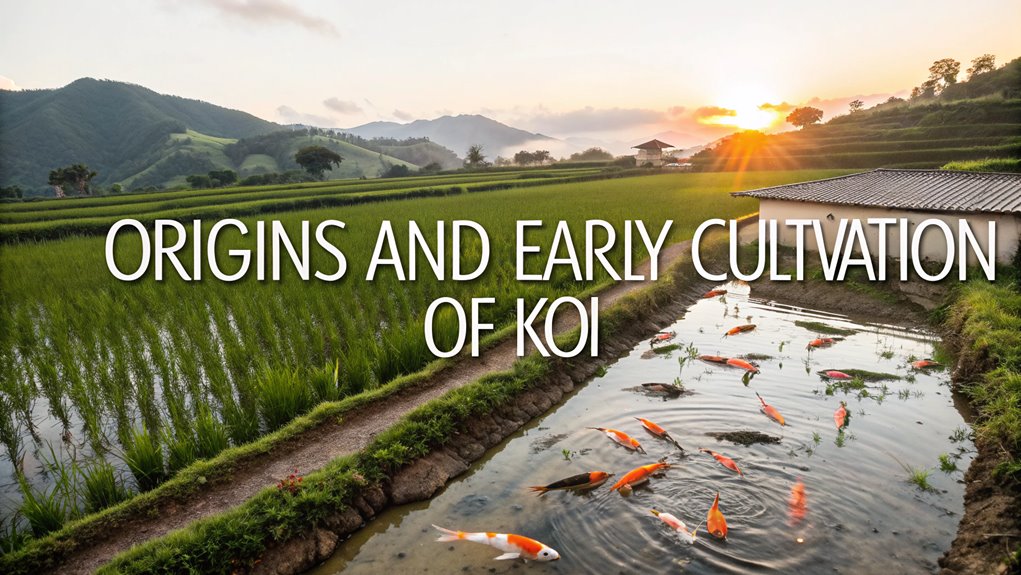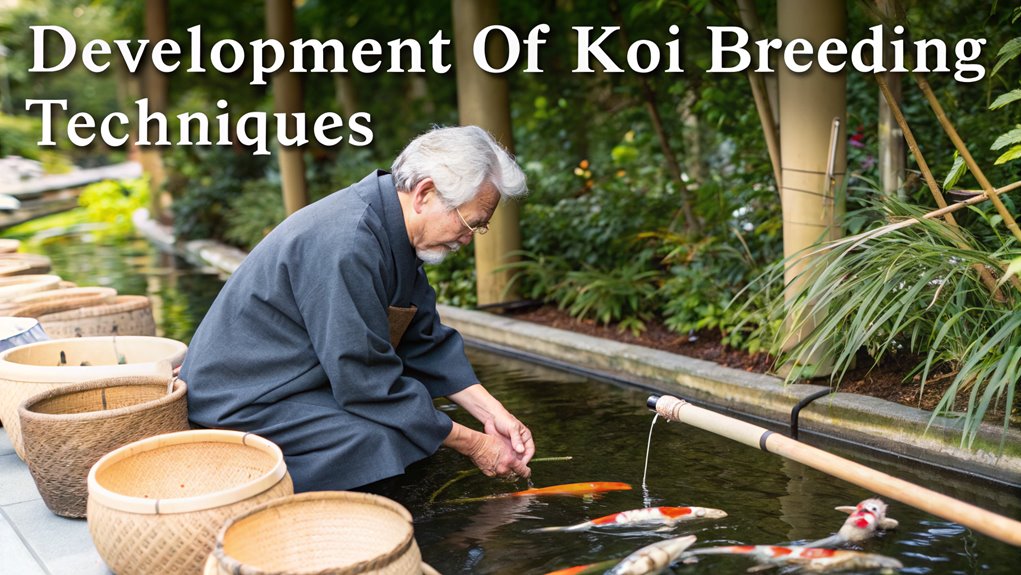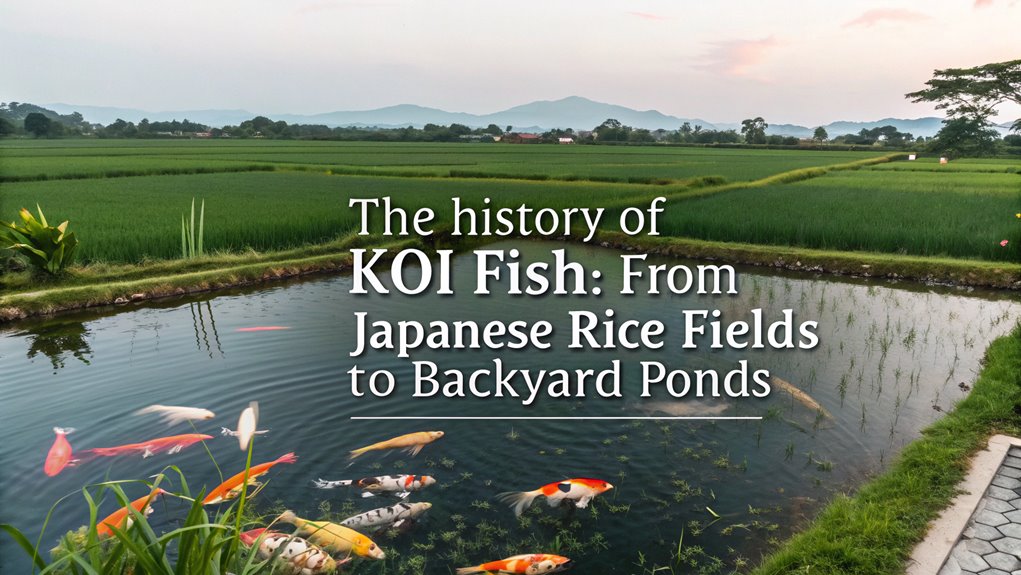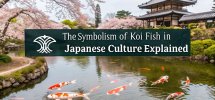Discover the fascinating history of koi fish, tracing back to China around 200 BC and evolving through Japan’s rice fields by the 19th century. Selective breeding in Japan led to stunning varieties like Kōhaku and Shōwa Sanshoku, celebrated for their color patterns. Koi symbolize resilience in Japanese culture and are now globally cherished, even fetching millions at auctions. Dive deeper into how koi have transformed from functional rice field inhabitants to ornamental gems in backyard ponds.
Key Facts Summarized
- Koi’s ancestry dates back to black carp in China around 200 BC, with selective breeding beginning in the 19th century.
- Systematic breeding in Japan’s Nijūmuragō area in the 1820s focused on color patterns and unique traits.
- Koi symbolize love and resilience in Japanese culture, with festivals celebrating their determination.
- Modern koi keeping is a global hobby, with ornamental ponds and high demand for quality koi.
- Over 100 diverse koi color patterns have been developed through systematic breeding practices.
Origins and Early Cultivation of Koi

While the ornamental koi that captivate modern enthusiasts are a product of selective breeding, their ancestry traces back to the black carp, or Magoi, introduced to Japan from China around 200 BC.
Rice farmers began refining these common carp through selective breeding in the early 19th century, focusing on color variation to produce ornamental koi. The first significant mutation occurred when Magoi displayed red bellies, leading to the emergence of Benigoi. This pivotal moment marked the dawn of nishikigoi cultivation.
The systematic breeding of koi gained momentum in the 1820s in Nijūmuragō, Japan, where farmers envisioned profit through diverse koi strains. By the late 19th century, the allure of these colorful fish skyrocketed, culminating in the adoption of the term “Nishikigoi” by 1910.
Development of Koi Breeding Techniques

As koi breeding techniques developed, the combination of genetic selection and environmental manipulation became crucial in producing new varieties. Originating in Nijūmuragō’s rice fields, systematic breeding of carp led to ornamental fish known as Nishikigoi. By the 1820s, rice farmers cultivated these fish, focusing on color patterns and unique traits. The Niigata Prefecture emerged as a pivotal koi breeding hub. Notable Nishikigoi varieties, such as Kōhaku, resulted from meticulous cross-breeding. Additionally, the importance of quality breeding stock became evident as breeders sought to enhance the traits of their koi.
| Year | Milestone |
|---|---|
| 1820s | Systematic breeding begins |
| 1875 | Popularity of colored koi increases |
| 1910s | Term “Nishikigoi” coined |
| 1917 | Sanke variety developed |
Breeders aimed for distinctive colors, including the striking black koi. The 1914 Tokyo Taisho Exposition showcased their achievements, sparking nationwide interest in koi breeding.
Varieties and Classifications of Koi

Although koi fish have captivated enthusiasts for generations, their classification into distinct varieties hinges on specific criteria such as coloration, patterning, and scalation.
Among the ornamental koi varieties, the Gosanke group reigns supreme, featuring Kōhaku with its white and red elegance, and Shōwa Sanshoku’s tri-color display. These colorful carp are the result of meticulous breeding efforts.
New varieties, like Butterfly koi with elongated fins and metallic scales, emerged in the 1980s, adding diversity to koi classification. The Kawarimono group serves as a catch-all for koi that defy standard categories, while the Goshiki variety offers a striking reticulated pattern. Koi varieties represent a unique blend of genetics and aesthetics, distinguishing them within the broader carp classification.
Cultural Significance of Koi in Japan
Koi fish, deeply embedded in Japanese culture, symbolize more than just ornamental beauty; they embody values like love, resilience, and prosperity. The term “koi” itself signifies love, linking these fish to human affection. They’re celebrated for resilience, inspired by legends of koi swimming upstream, emblematic of triumph over adversity. The species classification reveals varied symbolic meanings, such as Kohaku denoting purity and success, while Ogon signifies wealth. Koi’s cultural significance extends to art and literature, cementing their status in Japan’s heritage.
| Attribute | Symbolism |
|---|---|
| Kohaku | Purity, Success |
| Ogon | Wealth, Prosperity |
| Festivals | Endurance |
| Art & Literature | Cultural Heritage |
Koi festivals amplify their role as symbols of determination, vital to Japan’s cultural tapestry.
Modern Koi Keeping and Global Popularity
While koi fish have long held deep cultural significance in Japan, their allure has transcended borders, evolving into a global phenomenon.
Modern koi keeping has become a global hobby, where enthusiasts meticulously maintain ornamental ponds for these vibrant species. The demand for high-quality koi has skyrocketed, with wealthy Chinese collectors driving prices to unprecedented levels—one koi sold for approximately $2 million in 2018.
This surge in interest spurred systematic breeding practices, leading to over 100 diverse koi color patterns. These vibrant patterns are showcased in numerous koi shows worldwide, highlighting the species’ ornamental value. Additionally, koi are known for their unique personalities, making them not only beautiful pets but also engaging companions for owners.
Frequently Asked Questions
What Is the History of Japanese Koi Fish?
You analyze koi’s history, tracing their domestication from Cyprinus carpio in Japan circa 200 BC. Japanese cultivators selectively bred them, enhancing phenotypic diversity. Post-World War II, koi aquaculture resurged, diversifying genetic lineages and phenotypic classifications.
Why Were Koi Originally Kept in Ponds?
You’d find that 90% of early koi, *Cyprinus carpio*, thrived in ponds due to controlled environments. Ponds allowed precise management of genetic variations, enhancing ornamental traits through selective breeding, thus transforming koi into esteemed symbols of cultural prestige.
What Is the Chinese Myth About Koi Fish?
You’re diving into the Chinese myth where Cyprinus carpio, commonly known as koi, showcases resilience. They swim upstream, facing challenges, but those who reach the falls transform into dragons, symbolizing strength and metamorphic potential in Pisces mythology.
What Is the Japanese Saying About Koi Fish?
In Japanese culture, “koi no takinobori,” meaning “the koi fish swims upstream,” symbolizes resilience. Koi, scientifically classified as Cyprinus carpio, embody perseverance, with studies showing they can swim against currents up to 5 meters per second.
Conclusion
In your exploration of koi fish, you’ve traced their journey from humble beginnings in Japanese rice fields to becoming jewels of backyard ponds worldwide. Mastering koi breeding techniques has been pivotal, leading to the stunning varieties and classifications we appreciate today. Their cultural significance in Japan adds layers of richness, making koi more than just ornamental fish. As koi keeping gains global traction, you’re diving into a world where beauty and tradition swim hand in hand with scientific precision.


